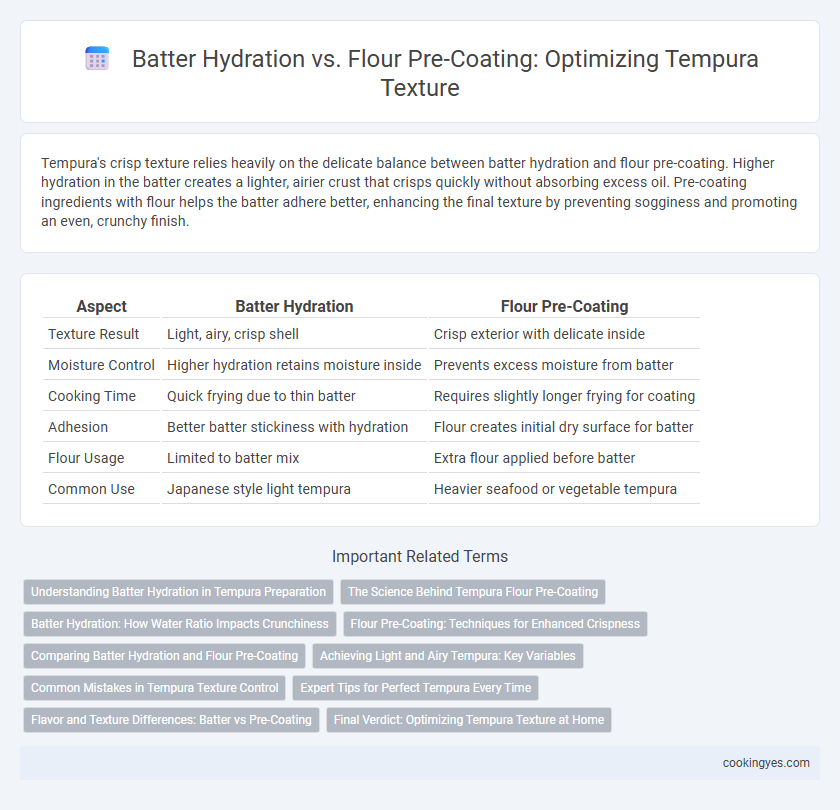Tempura's crisp texture relies heavily on the delicate balance between batter hydration and flour pre-coating. Higher hydration in the batter creates a lighter, airier crust that crisps quickly without absorbing excess oil. Pre-coating ingredients with flour helps the batter adhere better, enhancing the final texture by preventing sogginess and promoting an even, crunchy finish.
Table of Comparison
| Aspect | Batter Hydration | Flour Pre-Coating |
|---|---|---|
| Texture Result | Light, airy, crisp shell | Crisp exterior with delicate inside |
| Moisture Control | Higher hydration retains moisture inside | Prevents excess moisture from batter |
| Cooking Time | Quick frying due to thin batter | Requires slightly longer frying for coating |
| Adhesion | Better batter stickiness with hydration | Flour creates initial dry surface for batter |
| Flour Usage | Limited to batter mix | Extra flour applied before batter |
| Common Use | Japanese style light tempura | Heavier seafood or vegetable tempura |
Understanding Batter Hydration in Tempura Preparation
Higher hydration levels in tempura batter create a lighter, crispier texture by allowing steam to expand during frying, which reduces oil absorption. Using cold water and minimal mixing preserves the batter's delicate bubbles, enhancing the final crispiness. Pre-coating ingredients with a thin layer of flour ensures better batter adhesion and prevents sogginess by creating a moisture barrier.
The Science Behind Tempura Flour Pre-Coating
Flour pre-coating in tempura creates a barrier that minimizes moisture loss and enhances batter adhesion, resulting in a crisp, light texture. The science behind this technique involves the flour absorbing surface moisture, preventing excessive batter hydration that can lead to sogginess. Controlled hydration through pre-coating balances batter viscosity and frying temperature, optimizing the delicate, airy crunch that defines high-quality tempura.
Batter Hydration: How Water Ratio Impacts Crunchiness
Batter hydration significantly influences tempura's crunchiness, with a higher water-to-flour ratio creating a lighter, airier coating that crisps quickly without becoming heavy. Maintaining cold water and lower gluten flour enhances this effect by minimizing gluten development, which ensures a delicate texture. Optimal hydration balances moisture to produce a thin, brittle crust that resists oil saturation, resulting in the characteristic tempura crispness.
Flour Pre-Coating: Techniques for Enhanced Crispness
Flour pre-coating creates a dry surface on ingredients that enhances the batter's ability to cling, resulting in a crispier tempura texture. Techniques such as lightly dusting vegetables or seafood in cold flour before dipping in batter improve crust formation and reduce sogginess. This method optimizes moisture absorption and promotes a golden, crunchy finish essential to authentic tempura.
Comparing Batter Hydration and Flour Pre-Coating
Higher batter hydration in tempura creates a lighter, crisper texture due to increased steam generation during frying, while flour pre-coating enhances adhesion and prevents sogginess by forming a dry barrier. Comparing these methods, a well-hydrated batter yields a delicate, airy crust, whereas flour pre-coating provides structure and prevents batter slippage. Optimal tempura texture often balances both techniques to achieve crispiness without excessive oil absorption.
Achieving Light and Airy Tempura: Key Variables
Batter hydration plays a critical role in achieving light and airy tempura by controlling the moisture content, which affects crispness and oil absorption. Higher hydration levels create a thinner batter that crisps rapidly, while flour pre-coating adds a protective layer enhancing structural integrity and reducing sogginess. Balancing these variables ensures optimal texture, where the batter crisps lightly without becoming heavy or greasy, delivering the signature delicate crunch of perfect tempura.
Common Mistakes in Tempura Texture Control
Excessive batter hydration in tempura leads to a soggy, heavy coating that masks the delicate crispness of the ingredient. Relying solely on flour pre-coating without properly balancing moisture results in uneven frying and a chewy texture rather than a light, airy crust. Understanding the interaction between batter hydration levels and flour pre-coating is essential to achieve the ideal tempura texture, preventing common mistakes such as dense or greasy outcomes.
Expert Tips for Perfect Tempura Every Time
Achieving the ideal tempura texture relies on balancing batter hydration and flour pre-coating techniques. Expert chefs recommend using cold, iced water in the batter to maintain low gluten development, resulting in a light, crisp crust, while a light dusting of flour on ingredients helps excess moisture adhere without sogginess. Precise ratio control--typically a 1:1 flour-to-water volume--and minimal mixing prevent overworking, ensuring a delicate, airy tempura every time.
Flavor and Texture Differences: Batter vs Pre-Coating
Tempura batter hydration significantly impacts the final texture, creating a light, crispy shell that enhances the natural flavors of the ingredients without overpowering them. Flour pre-coating, by contrast, results in a denser, crunchier crust that can sometimes mask delicate tastes due to its thicker barrier. Optimal hydration levels in the batter allow for a thin, airy coating that maintains ingredient moisture and delivers a harmonious balance between crispiness and tenderness.
Final Verdict: Optimizing Tempura Texture at Home
Balancing batter hydration and flour pre-coating is crucial for achieving the ideal tempura texture, where a higher hydration batter creates a delicate, crispy shell, while flour pre-coating ensures even coating and moisture retention. Optimal tempura combines a thin, ice-cold batter with light flour dusting on ingredients, preventing excessive oil absorption and promoting a crisp finish. Experimenting with batter consistency around 1:3 rice flour to water ratio and light pre-coating preserves the signature airy crunch and golden color characteristic of authentic tempura.
Batter hydration vs flour pre-coating for tempura texture Infographic

 cookingyes.com
cookingyes.com